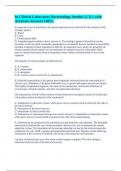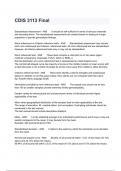In Clinical Laboratory Bacteriology Aerobic G-N || with
Accurate Answers 100%.
In suspected cases of brucellosis, the optimal specimen to be collected for the isolation of the
etiologic agent is
A. Blood
B. Urine
C. Cerebrospinal fluid
D. Nasopharyngeal exudates correct answers A. The etiologic agents of brucellosis are the
brucellae, which are small, nonmotile, gramnegative coccobacilli that are facultative intracellular
parasites. Isolation of these organisms is difficult. In suspected cases, which are generally job
related, multiple blood cultures are recommended for optimal recovery of the agent. Bone
marrow cultures have been found to be positive when cultures of blood failed to recover the
organism.
The majority of clinical isolates of Klebsiella are
A. K. ozaenae
B. K. pneumoniae
C. K. aerogenes
D. K. oxytoca correct answers B. K. pneumoniae
B. Klebsiella pneumoniae is the species most frequently recovered from the vast majority of
clinical cases. Members of the genus Klebsiella have a capsule and appear mucoid on cultures.
This highly encapsulated organism can cause severe pneumonia, nosocomial infections of
several types, infantile enteritis, and other extraintestinal infections.
The enterotoxins of both Vibrio cholerae Ol and noninvasive (toxigenic) strains of Escherichia
coli produce serious diarrhea by what mechanism?
A. Stimulation of adenylate cyclase, which gives rise to excessive fluid secretion by the cells of
the small intestine
B. Penetration of the bowel mucosa
C. Stimulation of colicin production
D. Elaboration of a dermonecrotizing toxin correct answers A. Stimulation of adenylate cyclase,
which gives rise to excessive fluid secretion by the cells of the small intestine
A. Enterotoxins are produced in the intestinal tract and primarily cause diarrhea. The heatlabile
enterotoxin of Escherichia coli, which resembles cholera toxin, acts to stimulate the enzyme
adenylate cyclase. The stimulation of the enzyme adenylate cyclase by the toxin increases the
production of cyclic AMP, causing rapid gastrointestinal fluid loss. Diarrhea results following
stimulation of the secretion of chloride ions by the cells lining the small intestine.
Colonies of Neisseria sp. turn color when a redox reagent is applied. The color change is
indicative of the activity of the bacterial enzyme
,A. Beta-galactosidase
B. Urease
C. Cytochrome oxidase
D. Phenylalanine deaminase correct answers C. Cytochrome oxidase
C. The genus Neisseria contains organisms that possess cytochrome oxidase activity. Colonies
can be identified by the development of a dark purple color following the application of
tetramethyl-p-phenylenediamine dihydrochloride. The reaction relies on the property of the
molecule to substitute for oxygen as an electron acceptor. In the presence of the enzyme and
atmospheric oxygen, the molecule is oxidized to form indophenol blue
Which of the following is not true of Shigella sonnei?
A. Large numbers of organisms must be ingested to produce disease.
B. The organism produces an inflammatory condition in the large intestine with bloody diarrhea.
C. The organism produces disease most commonly in the pediatric population.
D. The organism is a delayed lactose fermenter. correct answers A. Large numbers of organisms
must be ingested to produce disease
A. Shigella has a low infecting dose and has been reported to cause outbreaks in daycare centers
and can be spread to family members. These organisms are found in humans only at the time of
infection; they are not part of the normal flora. Transmission is by the fecal-oral route, typically
by ingestion of contaminated foods or water.
An environmental sampling study of respiratory therapy equipment produced
cultures of a yellow, nonfermentative (at 48 hours), gram-negative bacillus from several of the
nebulizers, which would most likely be species of
A. Chryseobacterium
B. Pseudomonas
C. Alcaligenes
D. Moraxella correct answers A. Chryseobacterium
A. Chryseobacterium spp. are ubiquitous in the environment and are especially associated with
moist soil and water. Chryseobacterium (formerly Flavobacterium) meningosepticum, a known
nosocomial pathogen, has been implicated in outbreaks of meningitis in hospitals and is
associated with the use of contaminated respiratory therapy equipment. Adult human infections
are rare; these opportunistic microorganisms occur primarily in immunocompromised patients
The characteristics of being lactose negative, citrate negative, urease negative, lysine
decarboxylase negative, and nonmotile best describe which organism?
A. Proteus vulgaris
B. Yersinia pestis
C. Salmonella enterica
,D. Shigella dysenteriae correct answers D. Shigella dysenteriae
D. Shigella dysenteriae, the type species of the genus, is a causative agent of bacillary dysentery.
Differential and selective media for the recovery of enteric pathogens from stool samples would
demonstrate Shigella species as H2S negative, non-lactose-fermenting, gram-negative bacilli.
Further biochemical testing would generally show these organisms to be unable to use citrate as
their sole carbon source, unable to decarboxylate the amino acid lysine, and urease negative.
A fermentative gram-negative bacillus that is oxidase positive, motile, and grows well on
MacConkey agar is
A. Aeromonas hydrophila
B. Pseudomonas aeruginosa
C. Stenotrophomonas maltophilia
D. Yersinia enterocolitica correct answers A. Aeromonas hydrophila is typically found in fresh
water and has been implicated in human infections. Growth on MacConkey agar and a positive
oxidase reaction are characterisic of this organism. A positive oxidase reaction differentiates this
organism from all of the Enterobacteriaceae, except the recently added Plesiomonas shigelloides.
On sheep blood agar, many strains of Aeromonas produce beta-hemolysis.
Fecal cultures are inoculated on thiosulfate-citrate-bile salts-sucrose agar specifically for the
isolation of
A. Shigella
B. Vibrio
C. Campylobacter
D. Salmonella correct answers B. A highly selective medium, thiosulfate-citratebile salt-sucrose
(TCBS) is used for the isolation of Vibrio spp. Species able to ferment sucrose, such as V.
cholerae, produce yellow colonies. Non-sucrose-fermenting organisms produce green colonies.
The K antigen of the family Enterobacteriaceae is
A. Heat labile
B. The somatic antigen
C. Located on the flagellum
D. The antigen used to group Shigella correct answers A. The K (capsule) antigen surrounds the
bacterial cell and masks the somatic antigens of the cell wall, which are used to group members
of the Enterobacteriaceae. These heat-labile antigens can be removed by heating a suspension of
the culture at 100°C for 10-30 minutes. Antisera that contain K antibody can be used to
demonstrate the presence of the capsular antigens.
The causative agent of melioidosis is
A. Burkholderia cepacia
B. Burkholderia pseudomallei
C. Moraxella catarrhalis
, D. Stenotrophomonas maltophilia correct answers B. Burkholderia pseudomallei is the causative
agent of melioidosis. The bacterium is found in soil and water in subtropical areas of Southeast
Asia and Australia. Melioidosis exhibits several forms, from skin abscesses to abscess formation
in internal organs.
Which microorganism will grow only on culture media supplemented with either cysteine or
cystine?
A. Actinobacillus lignieresii
B. Bartonella bacilliformis
C. Francisella tularensis
D. Kingella kingae correct answers C. Francisella tularensis requires cysteine or cystine for
growth. Glucose-cysteine with thiamine and cystine heart media are commercially available for
suspected cases of tularemia. They both require the addition of 5% sheep or rabbit blood.
Buffered charcoal yeast extract also supports the growth of F. tularensis, a medium generally
used by clinical laboratories for the cultivation of Legionella spp.
A culture of a decubitus ulcer grew a gram-negative facultative bacillus. On TSI it produced an
acid slant, acid butt, and gas. Test reactions in other media were as follows:
Citrate :negative
Indole :positive
Urease: negative
ONPG: positive
Voges-Proskauer: negative
The organism was identified as
A. Enterobacter cloacae
B. Escherichia coli
C. Citrobacter (diversus) koseri
D. Providencia stuartii correct answers B. Decubitus ulcers frequently contain normal intestinal
flora. The biochemical results are characteristic of Escherichia coli. E. coli is associated with a
variety of diseases; it is the predominant organism associated with cases of neonatal meningitis,
specticemia, cystitis, appendicitis, and endocarditis
An example of an oxidase-positive, glucose nonfermenting organism is
A. Aeromonas hydrophila
B. Escherichia coli
C. Klebsiella pneumoniae
D. Pseudomonas aeruginosa correct answers D. Pseudomonasa aendgnosa is the most commonly
encountered gram-negative species that is not a member of the family Enterobacteriaceae. It is
ubiquitous in nature and is found in homes and hospitals. It is an opportunistic pathogen
responsible for nosocomial infections.





